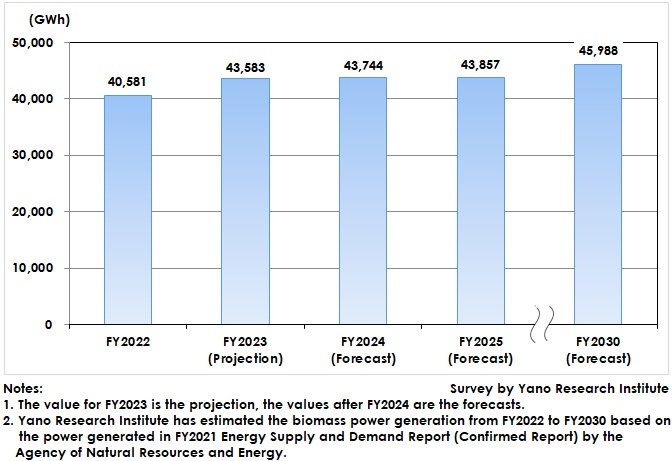No.3376
Biomass Energy Market in Japan: Key Research Findings 2023
Biomass Power Generation in Japan Expects 45,988GWh by FY2030
Yano Research Institute (the President, Takashi Mizukoshi) has conducted a survey on the biomass energy market in Japan and found out the market trends, the trends of leading market players, and future perspectives. Here clarifies the biomass power generation forecasts.

Market Overview
Biomass energy is renewable energy derived from organic resources of biological origin. It can be raw fuels (unutilized wood, general wood, construction waste, palm kernel shell, imported materials, sewage sludge, food waste, livestock excrement, etc.,) power generation electricity, heat (steam), and biofuels (bioethanol, biodiesel, bio jet fuels, etc.,) that are supplied to the market. This research has estimated the biomass power generation, that is woody biomass generated from unutilized wood, general wood, imported wood, etc. and methane fermentation biogas from organic waste such as sewage sludge, food waste livestock excrement, etc.
Japan’s biomass power generated in FY2022 is estimated at 40,581GWh, a considerable increase from the previous fiscal year, as a multiple number of large-scale woody biomass power plants with the capacity more than 10 MV have commenced the operations from the end of FY2021 to throughout FY2022.
FY2023 expects 43,583GWh of biomass power generation, 107.4% of that of preceding fiscal year, a smaller growth than the previous fiscal year. It is because of the feed in tariff scheme has been revised to introduce bidding for determining the purchase price at certification of segments, which has decelerated new construction of large-scale woody biomass power plants. Together with fiercer competition of fuel procurement, it has lowered the operation rates at some power plants.
Noteworthy Topics
Market Trends of Biomass Power Generation Not Using Feed-in Tariff
For woody biomass power generation, multiple companies are considering power generation projects under the feed in premium scheme in which a certain amount of premium (subsidy) is added to the market price. Many of such companies are those that have accumulated the knowhow on biomass power generation and electricity retailing business.
The feed-in premium scheme that has been newly introduced in FY2022, is the scheme to add premium to the price at which electricity is sold on the wholesale market. Under the scheme, power generation companies can choose the clients and the timing to sell electricity, which allows them to have an advantage of expanding the profits by selling electricity when the market price is high.
Some power generation companies are considering not to be dependent on the feed-in tariff or feed-in premium schemes, by setting the selling price of electricity that is responsive to volatile fuel prices and by viewing direct transactions with companies that need renewable energy. If such a move spread, it is possible for woody biomass power plants that do not use feed-in tariff scheme to be constructed in series from the mid-2020s to 2030.
Future Outlook
Biomass power generation is projected to be 45,988GWh by FY2030. Because of the declining number of new projects for large-scale woody biomass power plants, biomass power generation expects slight increase from FY2024.
What increase in introduction expected is methane fermentation biogas power generation from food wastes. Conventionally, introduction of biogas power generation from food wastes has centered on large-scale biogas plants with the capacity of 50 to 100 tons of food-waste processing per day.
In recent years, there have been an increasing number of requests by clients for methane fermentation biogas power generation from the processing of smaller amount of food wastes at best with some dozen tons per day. There are cases of commercial facilities considering the introduction of small biogas facilities. Therefore, deployment cases of methane fermentation biogas power generation, mainly the small-size cases, is projected to gradually increase through 2030.
Research Outline
2.Research Object: Biomass raw fuel suppliers, biofuel suppliers, biomass power generation businesses, biomass facility system manufacturers, etc.
3.Research Methogology: Face-to-face interviews (including online) by expert researchers, surveys via telephone, and literature search
The Biomass Energy Market
Biomass energy is renewable energy derived from organic resources of biological origin. It can be raw fuels (unutilized wood, general wood, construction waste, palm kernel shell, imported materials, sewage sludge, food waste, livestock excrement, etc.,) power generation electricity, heat (steam), and biofuels (bioethanol, biodiesel, bio jet fuels, etc.,) that are supplied to the market.
The Biomass Power Generation Market
Based on the power generated in FY2021 published in FY2021 Energy Supply and Demand Report (Confirmed Report) by the Agency of Natural Resources and Energy, Yano Research Institute has estimated the biomass energy generation from FY2022 to FY2030.
<Products and Services in the Market>
Woody biomass power generation, methane fermentation biogas power generation
Published Report
Contact Us
The copyright and all other rights pertaining to this report belong to Yano Research Institute.
Please contact our PR team when quoting the report contents for the purpose other than media coverage.
Depending on the purpose of using our report, we may ask you to present your sentences for confirmation beforehand.